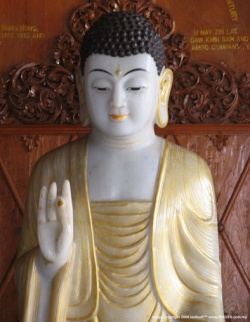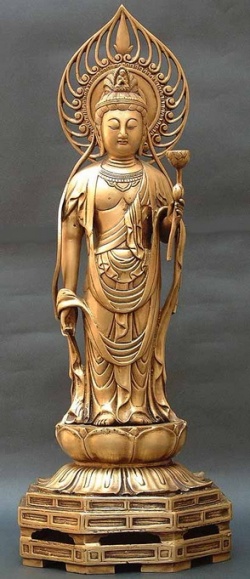Third Turning of Dharma Wheel
The Third Turning of the Dharma Wheel contain a number of various sutras, but the most significant among them is Tathāgatagarbha Sutra, which describes a primordial potentiality of awakening in each one of us, called Buddha Nature or Buddha-dhātu (element of Buddhahood).
This sutra later has been the main source of inspiration for Nagarjuna’s Collection of Praises and for treatise of Maitreya “Upper Tantra” (Uttaratantra Šastra).
In this sutra Buddha continued to develop the main topics started during the second turning of Dharma wheel: teachings on emptiness and transcendental experience of its realization on the Path to awakening.
However, due to the fact that the nature of emptiness, i.e. emptiness of intrinsic existence of all phenomena, was fully explained in great detail in wisdom sutras, it is not repeated during third turning of the dharma wheel again.
Distinctive feature of the third turning of the Dharma wheel is presentation of particular techniques of meditation,
intended to deepen the wisdom for realization of emptiness and discourse on several subtle moments related to practical application of that wisdom – how to become an embodiment of that wisdom, from subject’s viewpoint.
One more category of sutras is important, speaking about third turning of Dharma wheel.
Most significant among them is Samdhinirmocana Sutra (Sutra Revealing what is Intended).
In this sutra Buddha resolves the apparent contradiction between some of his teachings in the first turning of the Dharma wheel, attributing phenomena with some seeming self and an open rejection of the inner essence of the second turning of Dharma wheel.
To clear this contradiction Buddha is explaining teaching on emptiness, i.e. lack of identity, and shows that actually it should be applied differently to different types of phenomena.
Accordingly to this view, existence should be understood accordingly to three classes of phenomena: attributed, dependent and firmly established or highest.
To the class of Attributed phenomena are attributed those phenomena, which exist only as notions attributed to other phenomena with more substantive reality.
Here are related abstract entities, such as universals, relations, negations (for example, a lack of something), etc.
Class of dependent phenomena consists of all things and events created as a result of causes and conditions.
Class of firmly established phenomena is determined by the final, absolute mode of existence of all phenomena - namely, the emptiness.
From other perspective three classes mentioned above can be also seen as different from each other, but at the same time they express the universal in its nature types of all phenomena.
According to this view, they become in this case attributed nature, dependent nature and firmly established nature.
According to these three classes of nature, a different sense acquires also the sense of “lack of identity”.
For example, attributed phenomena lack inner identity, dependent phenomena lack self-established identity and firmly established phenomena lack an absolute identity.
For this reason the third turning of the Dharma wheel is also described as “Dharma wheel clearly explaining the differences”.
This understanding of teaching on absence of identity, explained during the third turning of Dharma wheel,
even it had some conflicts with the spirit of wisdom sutras, can be seen as a very effective method to reach the goal, applied by Buddha.
During the second turning of the Dharma wheel, the principle of lack of identity was represented as universal teaching, expressed directly from positions of intrinsic emptiness of all phenomena.
However this understanding of emptiness may appear too extraordinary for many practitioners and thus be beyond of their experience.
A statement that phenomena don’t have any intrinsic existence might appear to them as equal to a statement that phenomena don’t exist at all.
According to their approach the lack of substantial existence may mean non-existence.
Here we can see why Buddha presented his teaching in sutras of the third turning of Dharma wheel specifically for practitioners with a certain mindset.
Accordingly to these two different ways of interpretation of the Teaching on emptiness, presented in wisdom sutras,
two main branches of Mahayana Buddhism developed in India:
Madhyamaka, or the Middle Path, and
Cittamatra or “Mind Only”.
Tibetan Buddhist tradition has also a very developed system of theory and practice known as Tantra. It is related to the third turning of the Dharma wheel.
The word "tantra" literally means "continuum" or "continuity."
Tantra of the ultimate Vajra - the text of yoga class of tantras, explains that “Tantra” means continuity, relating primarily to the continuity of the mind or consciousness:
“Tantra is continuity, samsara is tantra.”
First of all, our flow of consciousness - is the foundation for our self-perception as a person.
Due to this continuum our performed contaminated actions are forcing us to continually move on through the vicious cycle of deaths and new rebirths.
When we speak about spiritual path, it is due to this continuity of consciousness that we are able to improve condition of our mind and reach more advanced stages on the path.
And finally, due to the same continuity of consciousness, which is often identified with our Buddha nature, we are able to reach the ultimate enlightenment.
In other words, samsara (our conditioned existence in continuous wheel of usual tendencies)and Nirvana (final liberation from such existence) – are nothing else but different manifestations of the same primordial continuity.
Thus, the uninterrupted flow of consciousness is always there.
That’s what means tantra or continuity.
Tantric teachings are very tightly connected to the third turning of the wheel of Dharma, explained by Buddha.
Tantra is a system of theory and practice intended to assist to manifest currently hidden powers of primordial continuity of our consciousness and the goal of the teachings of the third turning of the Dharma wheel is the same.
Actually, if we carefully review teachings of second and third turnings of the Dharma wheel, we can find essential features of the tantric teaching.
They both together form a valuable link between teachings of sutras and tantras.
For example, the hermeneutical approach, which coordinates readings of wisdom sutras in two different ways – literary, providing the teaching on emptiness, and the hidden, describing stages on the path in relation to experience of realization of emptiness,
is paving the way for the adoption of the idea of the different interpretations of the same text, which is crucial for the understanding of tantric teachings.
Similarly, in regard to the topic of different levels of subtlety of perception of emptiness from the point of view of the subject’s mind,
the third turning of the Dharma wheel makes it possible to discuss in tantra many levels of subtlety of the consciousness of the practitioner and their connection with realization of various transcendental states.

